Spatiotemporal Changes in Evapotranspiration from an Overexploited Water Resources Basin in Arid Northern China and Their Implications for Ecosystem Management
Abstract
:1. Introduction
2. Materials and Methods
2.1. Study Area
2.2. Data and Analysis Method
3. Results
3.1. Spatial Distribution of ET
3.2. Temporal Variation in ET
3.3. Characteristics of ET-Based Water Consumption in Farmland
4. Discussion
4.1. Bias in ET Estimation
4.2. Factors Possibly Affecting ET
4.3. ET Dynamics and Their Implications for Ecosystem Management
5. Conclusions
Author Contributions
Funding
Acknowledgments
Conflicts of Interest
References
- Liu, J.G.; Mooney, H.; Hull, V.; Davis, S.J.; Gaskell, J.; Hertel, T.; Lubchenco, J.; Seto, K.C.; Gleick, P.; Kremen, C.; et al. Systems integration for global sustainability. Science 2015, 347, 1–9. [Google Scholar] [CrossRef]
- Li, X.; Yang, K.; Zhou, Y.Z. Progress in the study of oasis-desert interactions. Agric. For. Meteorol. 2016, 230–231, 1–7. [Google Scholar] [CrossRef]
- Anderson, M.C.; Norman, J.M.; Kustas, W.P.; Houborg, R.; Starks, P.J.; Agam, N. A thermal-based remote sensing technique for routine mapping of land-surface carbon, water and energy fluxes from field to regional scales. Remote Sens. Environ. 2008, 112, 4227–4241. [Google Scholar] [CrossRef]
- Yang, Y.T.; Long, D.; Guan, H.D.; Liang, W.; Simmons, C.T.; Batelaan, O. Comparison of three dual-source remote sensing evapotranspiration models during the MUSOEXE-12 campaign: Revisit of model physics. Water Resour. Res. 2015, 51, 3145–3165. [Google Scholar] [CrossRef] [Green Version]
- Li, X.; Cheng, G.D.; Ge, Y.C.; Li, H.Y.; Han, F.; Hu, X.L.; Tian, W.; Tian, Y.; Pan, X.D.; Nian, Y.Y.; et al. Hydrological cycle in the Heihe River Basin and its implication for water resource management in endorheic basins. J. Geophys. Res. Atmos. 2018, 123, 890–914. [Google Scholar] [CrossRef]
- Zhou, Y.Z.; Li, X.; Yang, K.; Zhou, J. Assessing the impacts of an ecological water diversion project on water consumption through high-resolution estimations of actual evapotranspiration in the downstream regions of the Heihe River Basin, China. Agric. For. Meteorol. 2018, 249, 210–227. [Google Scholar] [CrossRef]
- FAO. Arid Zone Forestry: A Guide for Field Technicians. Available online: http://www.fao.org/docrep/t0122e/t0122e03.htm#1.%20meaning%20of%20aridity (accessed on 20 October 2018).
- Cheng, G.D.; Li, X.; Zhao, W.Z.; Xu, Z.M.; Feng, Q.; Xiao, S.C.; Xiao, H.L. Integrated study of the water–ecosystem–economy in the Heihe River Basin. Natl. Sci. Rev. 2014, 3, 413–428. [Google Scholar] [CrossRef]
- Li, Y.P.; Nie, S.; Huang, C.Z.; McBean, E.A.; Fan, Y.R.; Huang, G.H. An integrated risk analysis method for planning water resource systems to support sustainable development of an arid aegion. J. Environ. Inf. 2017, 29, 1–15. [Google Scholar]
- Zheng, M.S.; Ma, L.K.; Li, T.H.; Huang, R. Rapid assessment method for wco-water deficit in catchments. J. Environ. Inf. 2017, 30, 149–160. [Google Scholar]
- Shen, Y.; Chen, Y. Global perspective on hydrology, water balance, and water resources management in arid basins. Hydrol. Process. 2010, 24, 129–135. [Google Scholar] [CrossRef]
- Zhao, L.W.; Zhao, W.Z. Water balance and migration for summer maize in an oasis farmland of northwest China. China Sci. Bull. 2014, 59, 4829–4837. [Google Scholar] [CrossRef]
- Qiu, G.Y.; Li, C.; Yan, C.H. Characteristics of soil evaporation, plant transpiration and water budget of Nitraria dune in the arid Northwest China. Agric. For. Meteorol. 2015, 203, 107–117. [Google Scholar] [CrossRef]
- Papadavid, G.; Hadjimitsis, D.G.; Toulios, L.; Michaelides, S. A modified SEBAL modeling approach for estimating crop evapotranspiration insemi-arid conditions. Water Resour. Manag. 2013, 27, 3493–3506. [Google Scholar] [CrossRef]
- Ma, Z.M.; Kang, S.Z.; Zhang, L.; Tong, L.; Su, X.L. Analysis of impacts of climate variability and human activity on streamflow for a river basin in arid region of northwest China. J. Hydrol. 2008, 352, 239–249. [Google Scholar] [CrossRef]
- Zhang, Y.L.; Ma, J.H.; Chang, X.L.; Wonderen, J.V.; Yan, L.L.; Han, J.H. Water resources assessment in the Minqin Basin: An arid inland river basin under intensive irrigation in northwest China. Environ. Earth Sci. 2012, 65, 1831–1839. [Google Scholar] [CrossRef]
- Ma, J.Z.; Wang, X.S.; Edmunds, W.M. The characteristics of ground-water resources and their changes under the impacts of human activity in the arid Northwest China—A case study of the Shiyang River Basin. J. Arid Environ. 2005, 61, 277–295. [Google Scholar] [CrossRef]
- Kang, S.Z.; Su, X.L.; Tong, L.; Shi, P.Z.; Yang, X.Y.; Abe, Y.K.; Du, T.S.; Shen, Q.L.; Zhang, J.H. The impacts of human activities on the water–land environment of the Shiyang River basin, an arid region in northwest China. Hydrol. Sci. J. 2004, 49, 413–427. [Google Scholar] [CrossRef]
- Geng, G.; Wardlaw, R. Application of Multi-Criterion Decision Making Analysis to Integrated Water Resources Management. Water Resour. Manag. 2013, 27, 3191–3207. [Google Scholar] [CrossRef]
- Li, C.; Wang, Y.; Qiu, G.Y. Water and energy consumption by agriculture in the Minqin Oasis Region. J. Integr. Agric. 2013, 12, 1330–1340. [Google Scholar] [CrossRef]
- Sun, Y.; Kang, S.Z.; Li, F.S.; Zhang, L. Comparison of interpolation methods for depth to groundwater and its temporal and spatial variations in the Minqin oasis of northwest China. Environ. Model. Softw. 2009, 24, 1163–1170. [Google Scholar] [CrossRef]
- Hao, Y.Y.; Xie, Y.W.; Ma, J.H.; Zhang, W.P. The critical role of local policy effects in arid watershed groundwater resources sustainability: A case study in the Minqin oasis, China. Sci. Total Environ. 2017, 602, 1084–1096. [Google Scholar] [CrossRef]
- Aarnoudse, E.; Bluemling, B.; Wester, P.; Qu, W. The role of collective groundwater institutions in the implementation of direct groundwater regulation measures in Minqin County, China. Hydrogeol. J. 2012, 20, 1213–1221. [Google Scholar] [CrossRef]
- Sun, D.F. Detection of dryland degradation using Landsat spectral unmixing remote sensing with syndrome concept in Minqin County, China. Int. J. Appl. Earth Observ. Geoinf. 2015, 41, 34–45. [Google Scholar] [CrossRef]
- Mu, Q.Z.; Zhao, M.S.; Running, S.W. Improvements to a MODIS Global Terrestrial Evapotranspiration Algorithm. Remote Sens. Environ. 2011, 115, 1781–1800. [Google Scholar] [CrossRef]
- Mu, Q.Z.; Heinsch, F.A.; Zhao, M.S. Development of a global evapotranspiration algorithm based on MODIS and global meteorology data. Remote Sens. Environ. 2007, 111, 519–536. [Google Scholar] [CrossRef]
- Xiong, Y.; Zhao, S.; Yin, J.; Li, C.; Qiu, G. Effects of Evapotranspiration on Regional Land Surface Temperature in an Arid Oasis Based on Thermal Remote Sensing. IEEE Geosci. Remote Sens. Lett. 2016, 13, 1885–1889. [Google Scholar] [CrossRef]
- Xiong, Y.J.; Zhao, S.H.; Tian, F.; Qiu, G.Y. An evapotranspiration product for arid regions based on the three-temperature model and thermal remote sensing. J. Hydrol. 2015, 530, 392–404. [Google Scholar] [CrossRef] [Green Version]
- Zhang, K.; Kimball, J.S.; Running, S.W. A review of remote sensing based actual evapotranspiration estimation. Wiley Interdiscip. Rev. Water 2016, 3, 834–853. [Google Scholar] [CrossRef]
- WRBGP. Water Resources Bulletin of Gansu Province. 2012. Available online: http://www.gssl.gov.cn/xxgk/gkml/nbgb/szygb/ (accessed on 20 October 2018).
- Si, S.H.; Zhu, G.F.; Su, Y.H. The characteristics of water cycle and its ecological functions for inland river basin in northwestern China. J. Arid Land Resour. Environ. 2010, 24, 37–44. [Google Scholar]
- Xu, Z.G.; Bennett, M.T.; Tao, R.; Xu, J.T. China’s Sloping Land Conversion Programme four years on: Current situation, pending issues. Int. For. Rev. 2004, 6, 317–326. [Google Scholar]
- Dong, Z.L.; Xu, X.Y.; Jin, H.X.; Liu, S.J.; Zhang, J.H.; Tang, W.D.; Chai, C.W.; Zhao, P.; Wang, X.H. The impact of eco-water transportation to the vegetation in tail lake of Shiyang River. J. Arid Land Resour. Environ. 2015, 29, 101–106. [Google Scholar]
- Zhu, Q.; Li, Y. Environmental Restoration in the Shiyang River Basin, China: Conservation, Reallocation and More Efficient Use of Water. Aquat. Procedia 2014, 2, 24–34. [Google Scholar] [CrossRef]
- Tang, Z.G.; Ma, J.H.; Peng, H.H.; Wang, S.H.; Wei, J.F. Spatiotemporal changes of vegetation and their responses to temperature and precipitation in upper Shiyang river basin. Adv. Space Res. 2017, 60, 969–979. [Google Scholar] [CrossRef]
- Howell, T.A. Enhancing water use efficiency in irrigated agriculture. Agron. J. 2001, 93, 281–289. [Google Scholar] [CrossRef]
- Zhang, Y.Q.; Kendy, E.; Qiang, Y.; Liu, C.M.; Shen, Y.J.; Sun, H.Y. Effect of soil water deficit on evapotranspiration, crop yield, and water use efficiency in the North China Plain. Agric. Water Manag. 2004, 64, 107–122. [Google Scholar] [CrossRef]
- Pradeep, W.; Prasanna, H.G.; Xiao, X.M.; Anup, K.C. Parameterizing ecosystem light use efficiency and water use efficiency to estimate maize gross primary production and evapotranspiration using MODIS EVI. Agric. For. Meteorol. 2016, 222, 87–97. [Google Scholar] [Green Version]
- Pastori, M.; Udias, A.; Bouraoui, F.; Bidoglio, G. A multi-objective approach to evaluate the economic and environmental impacts of alternative water and nutrient management strategies in Africa. J. Environ. Inf. 2017, 29, 16–28. [Google Scholar] [CrossRef]
- Joiner, J.; Yoshida, Y.; Anderson, M.; Holmes, T.; Hain, C.; Reichle, R.; Koster, R.; Middleton, E.; Zeng, F. Global relationships among traditional reflectance vegetation indices (NDVI and NDII), evapotranspiration (ET), and soil moisture variability on weekly timescales. Remote Sens. Environ. 2018, 219, 339–352. [Google Scholar] [CrossRef]
- Martens, B.; Miralles, D.G.; Lievens, H.; van der Schalie, R.; de Jeu, R.A.M.; Fernández-Prieto, D.; Beck, H.E.; Dorigo, W.A.; Verhoest, N.E.C. GLEAM v3: Satellite-based land evaporation and root-zone soil moisture. Geosci. Model Dev. 2017, 10, 1903–1925. [Google Scholar] [CrossRef]
- Jung, M.; Reichstein, M.; Ciais, P.; Seneviratne, S.I.; Sheffield, J.; Goulden, M.L.; Bonan, G.; Cescatti, A.; Chen, J.; de Jeu, R.; et al. A recent slowdown in global land evapotranspiration due to limited moisture supply. Nature 2010, 467, 951–954. [Google Scholar] [CrossRef]

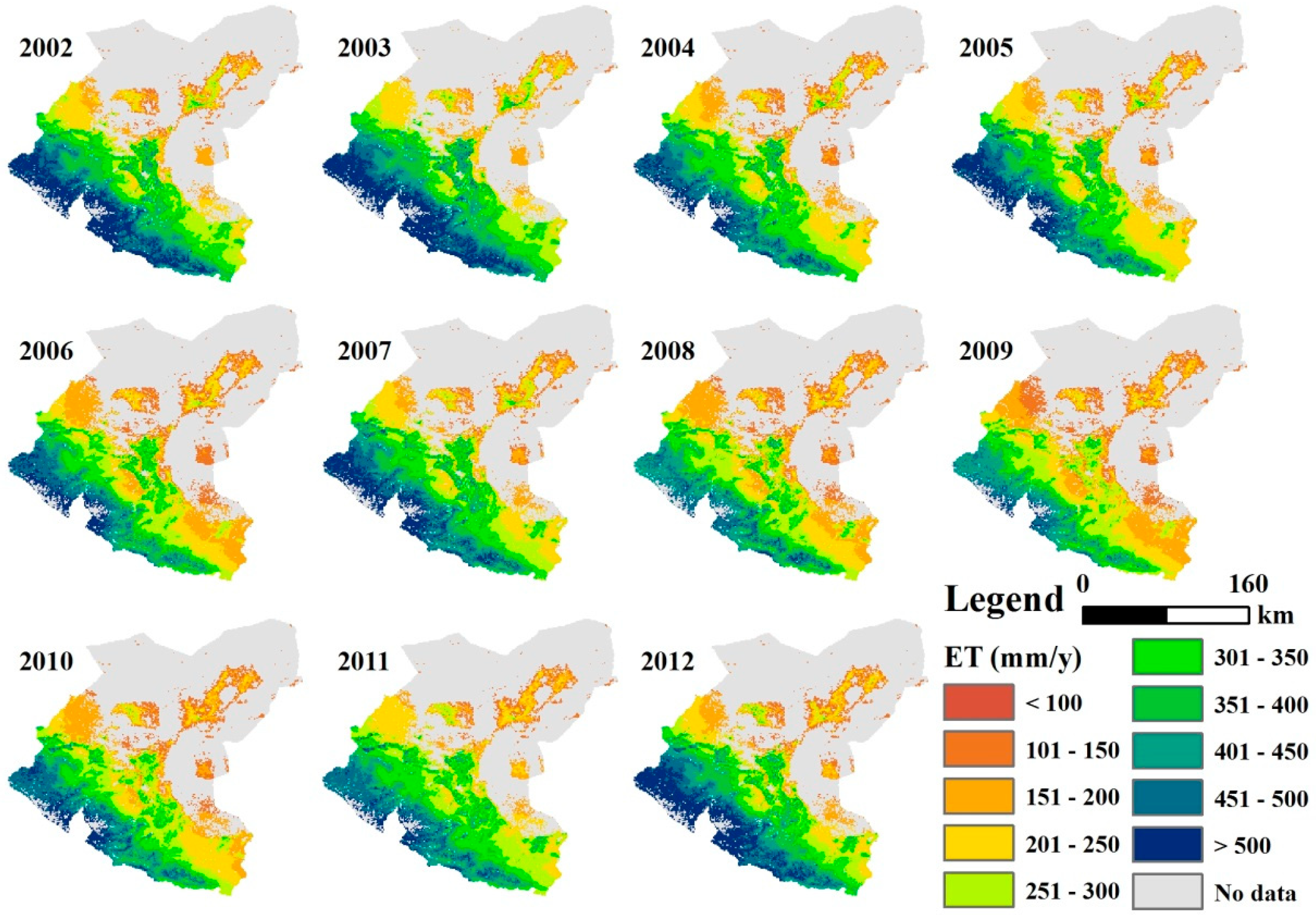
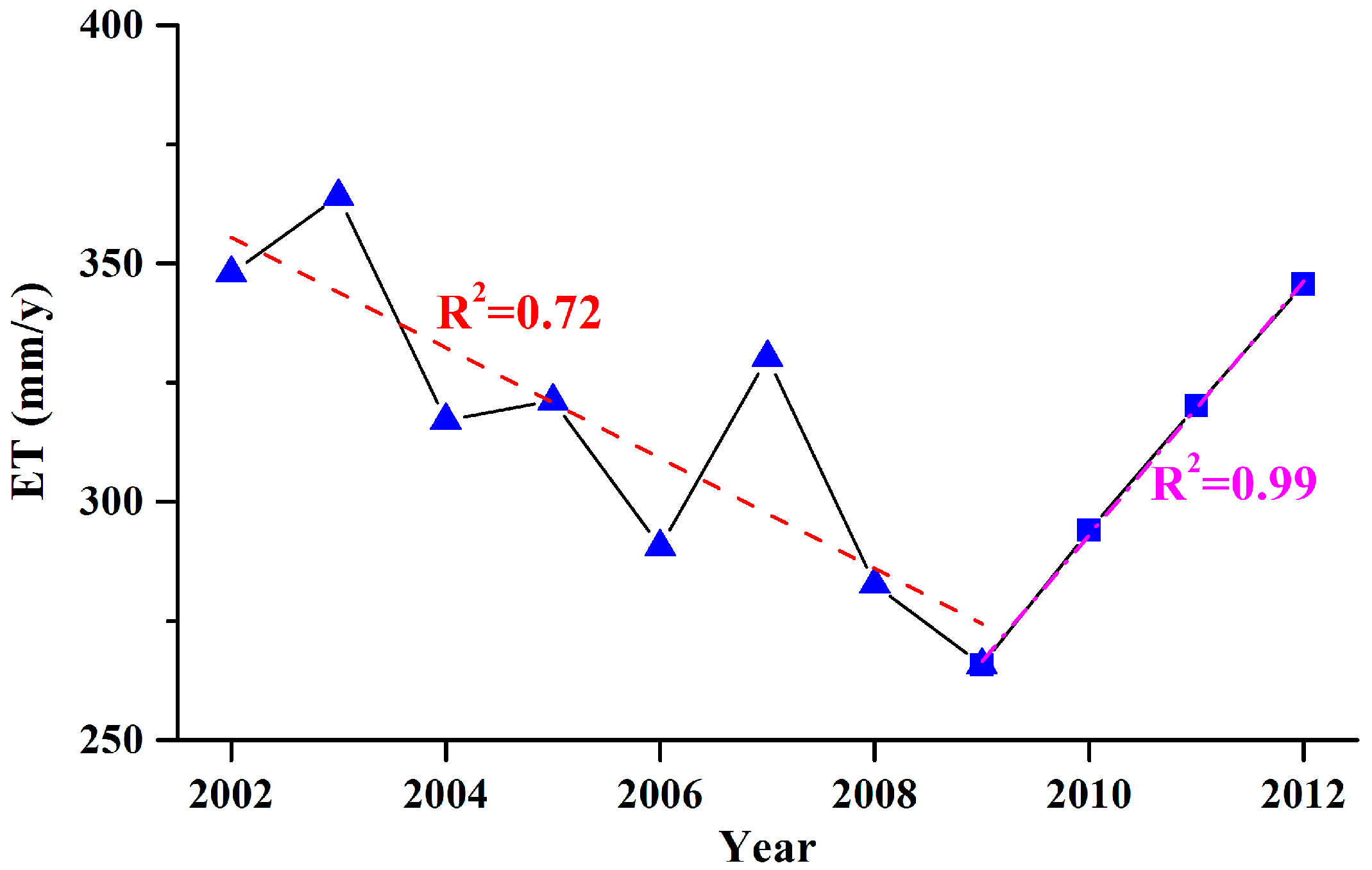
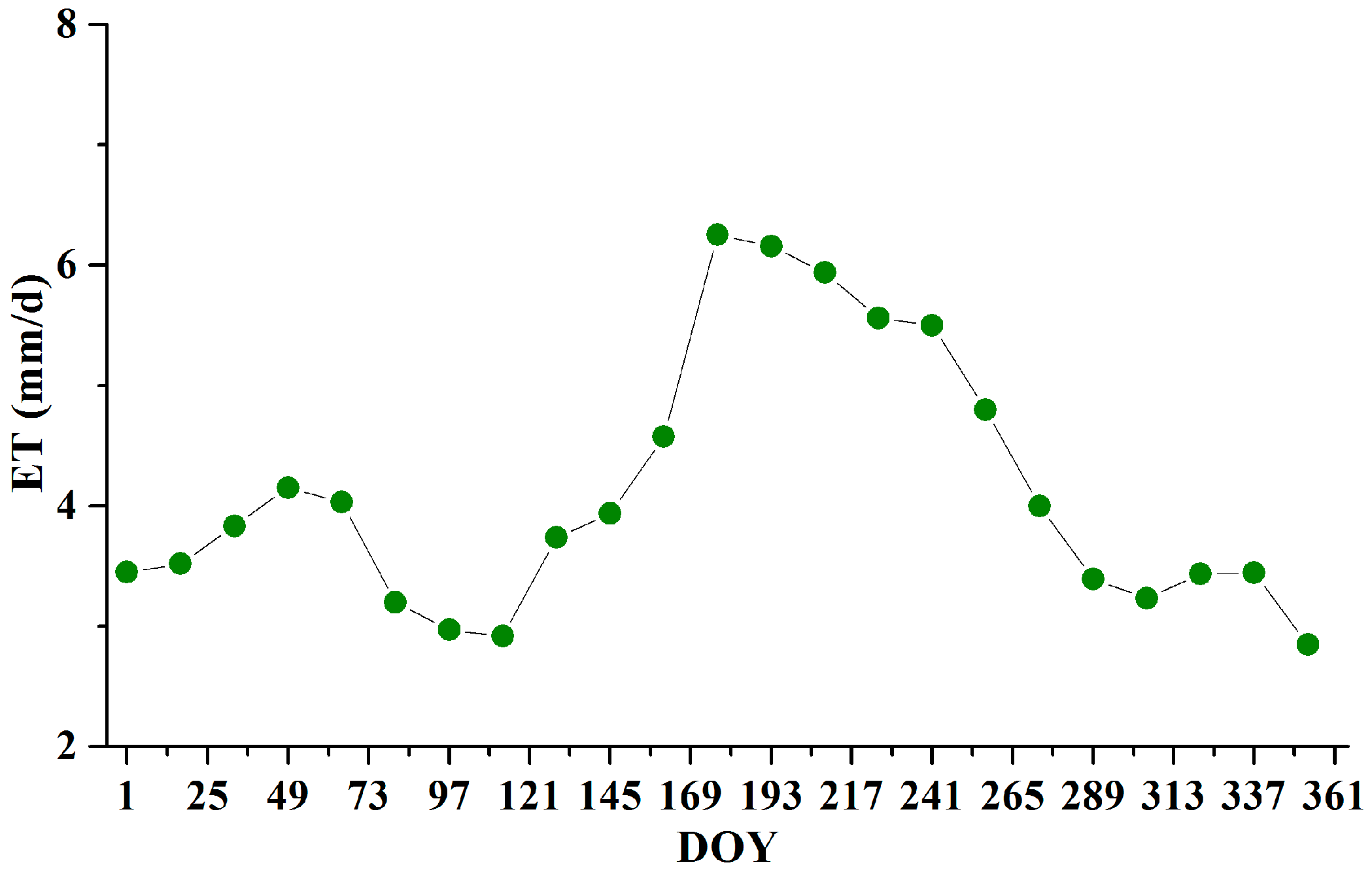
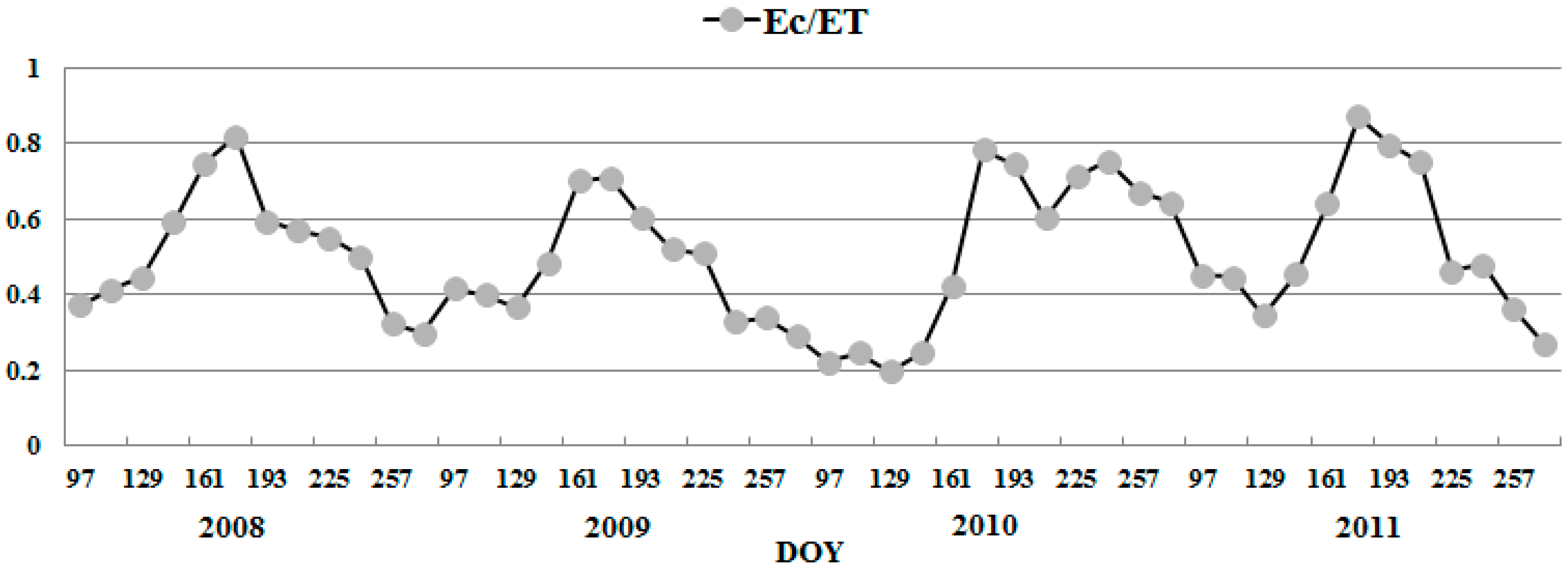
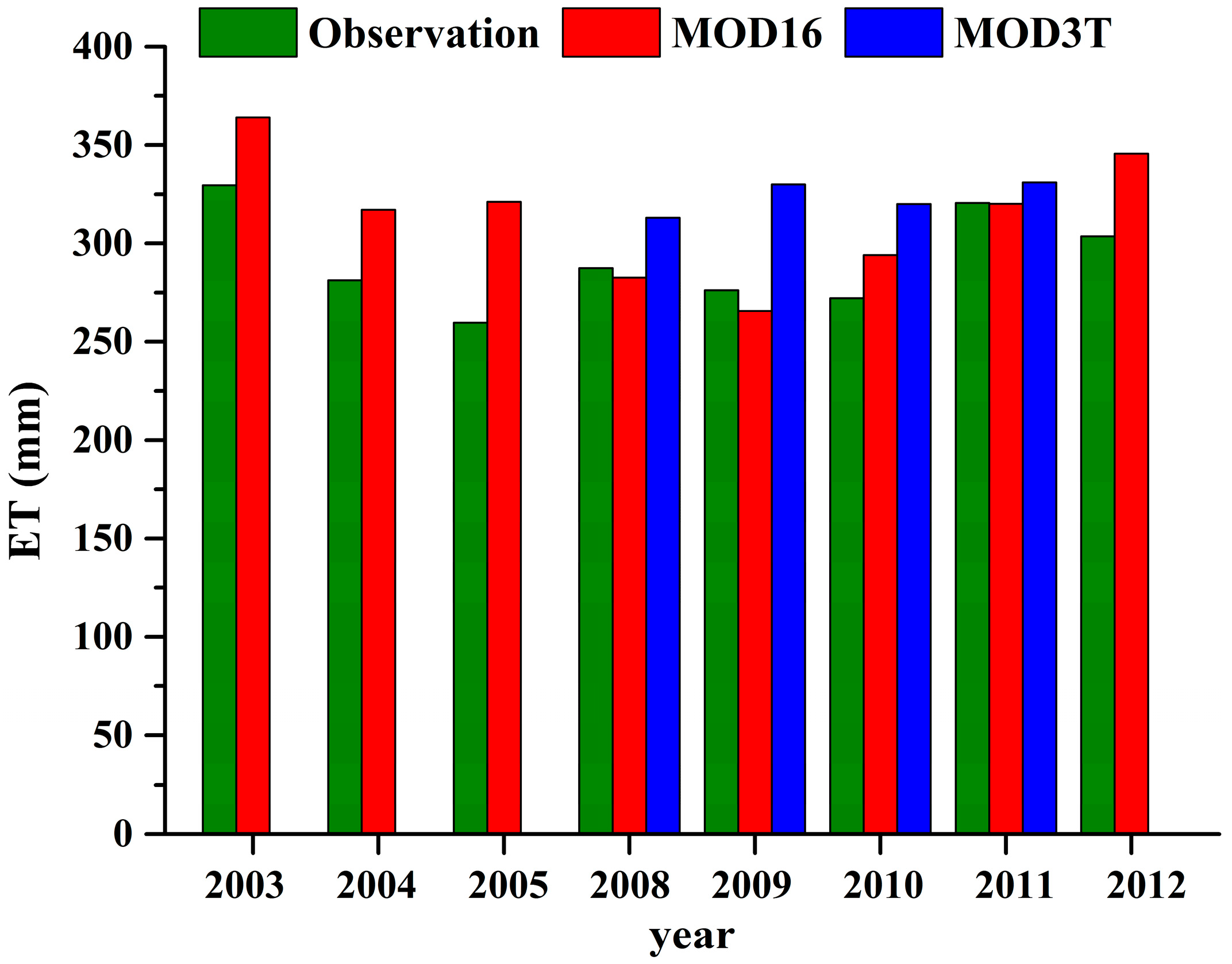
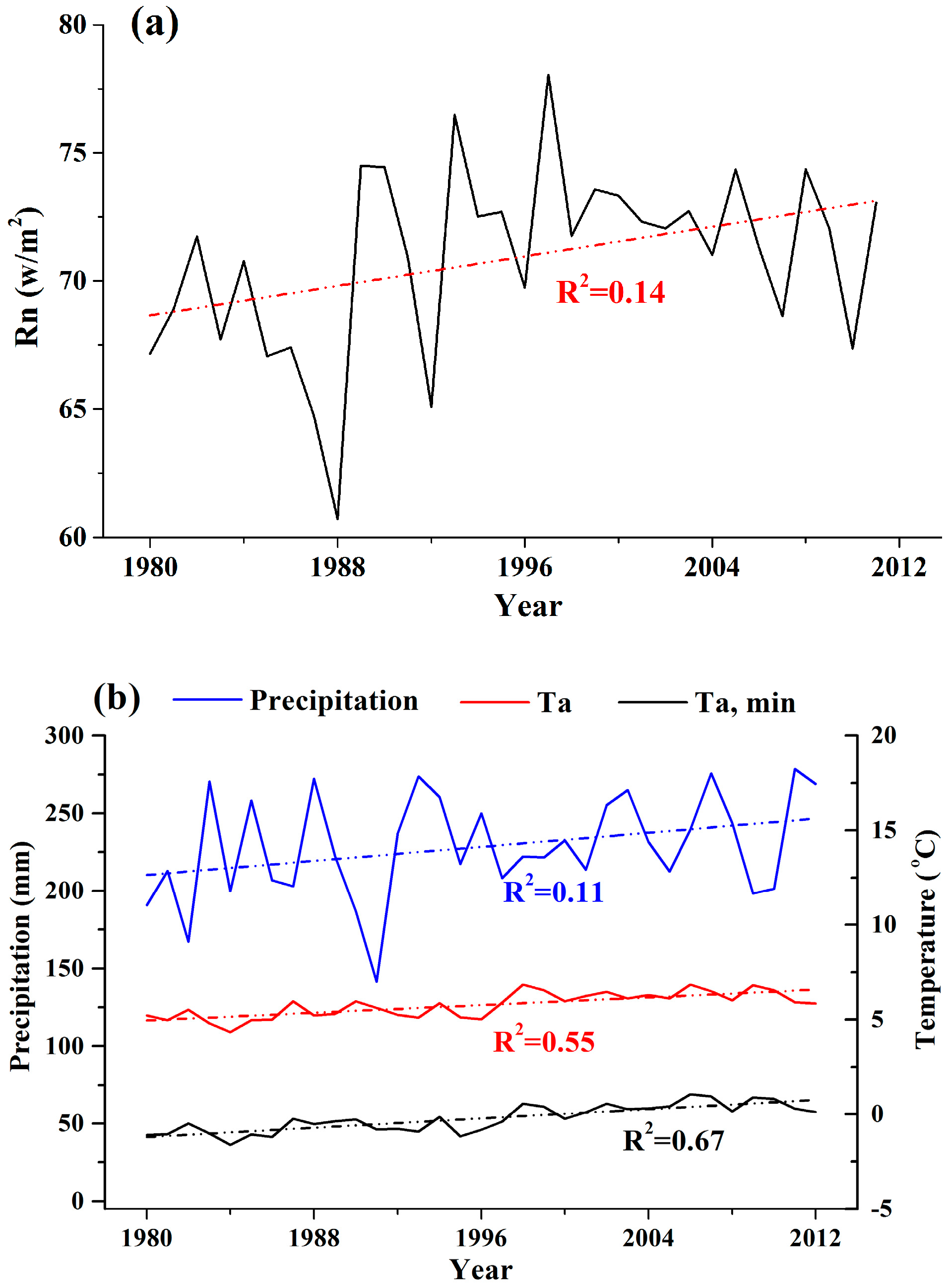
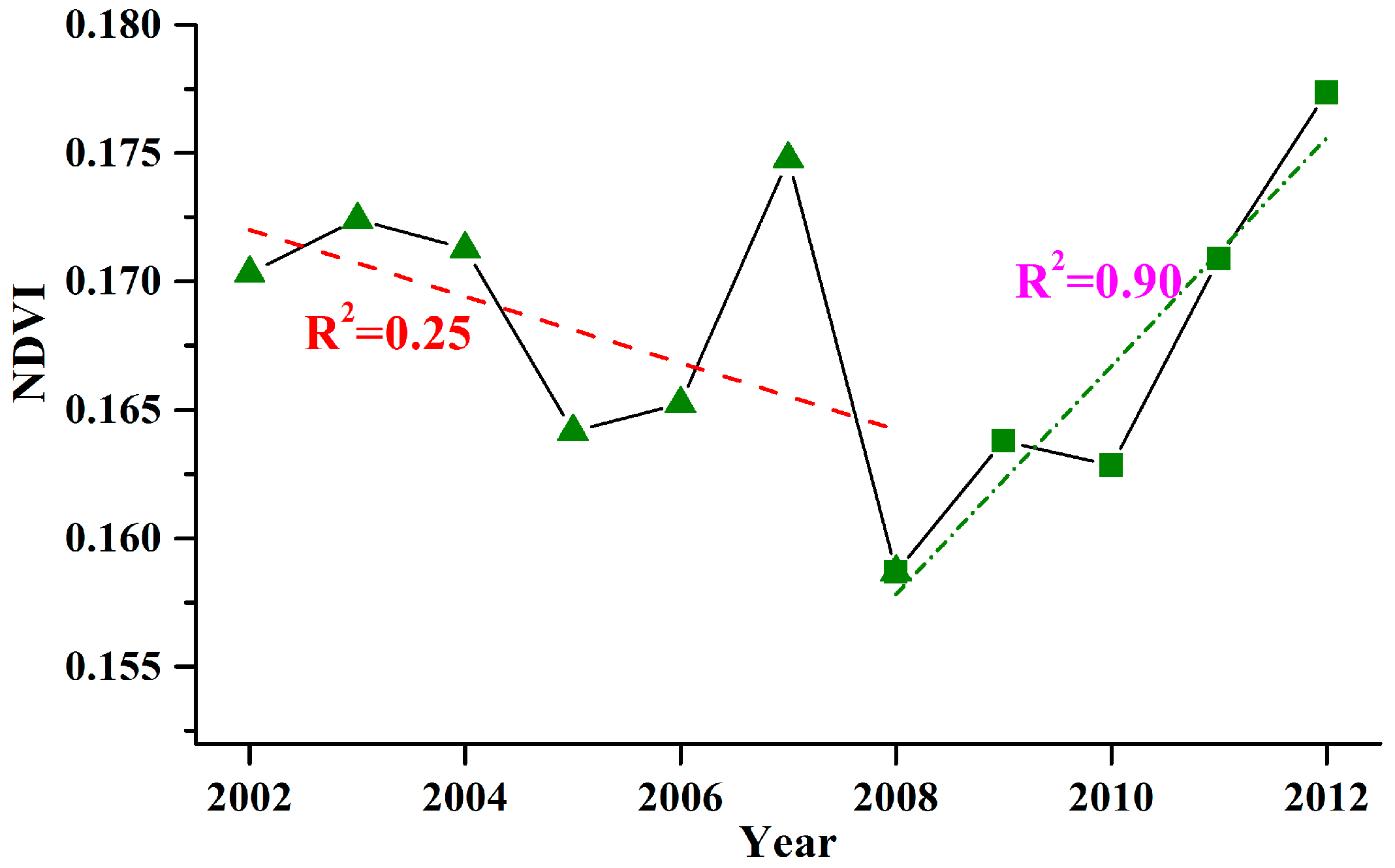
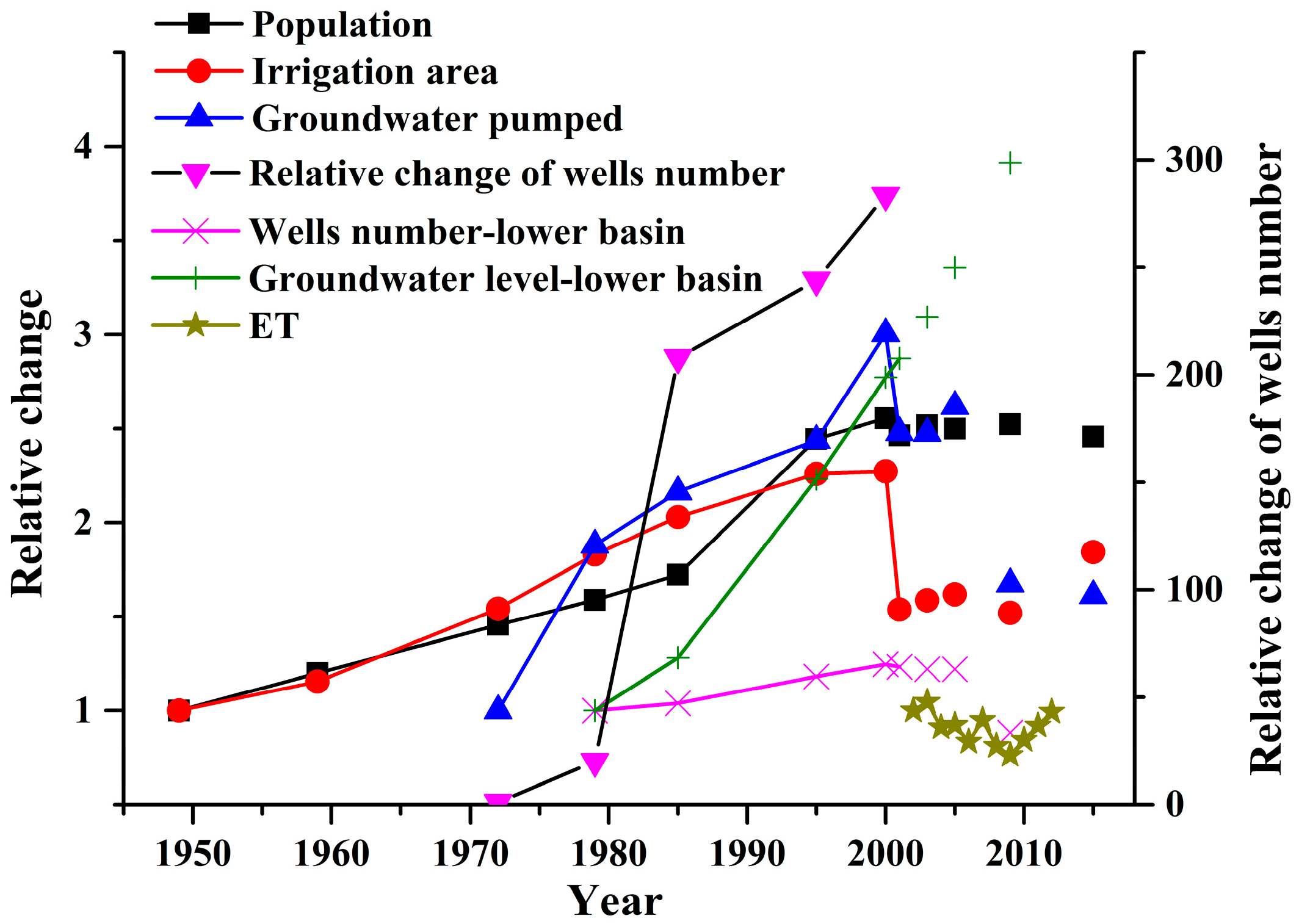
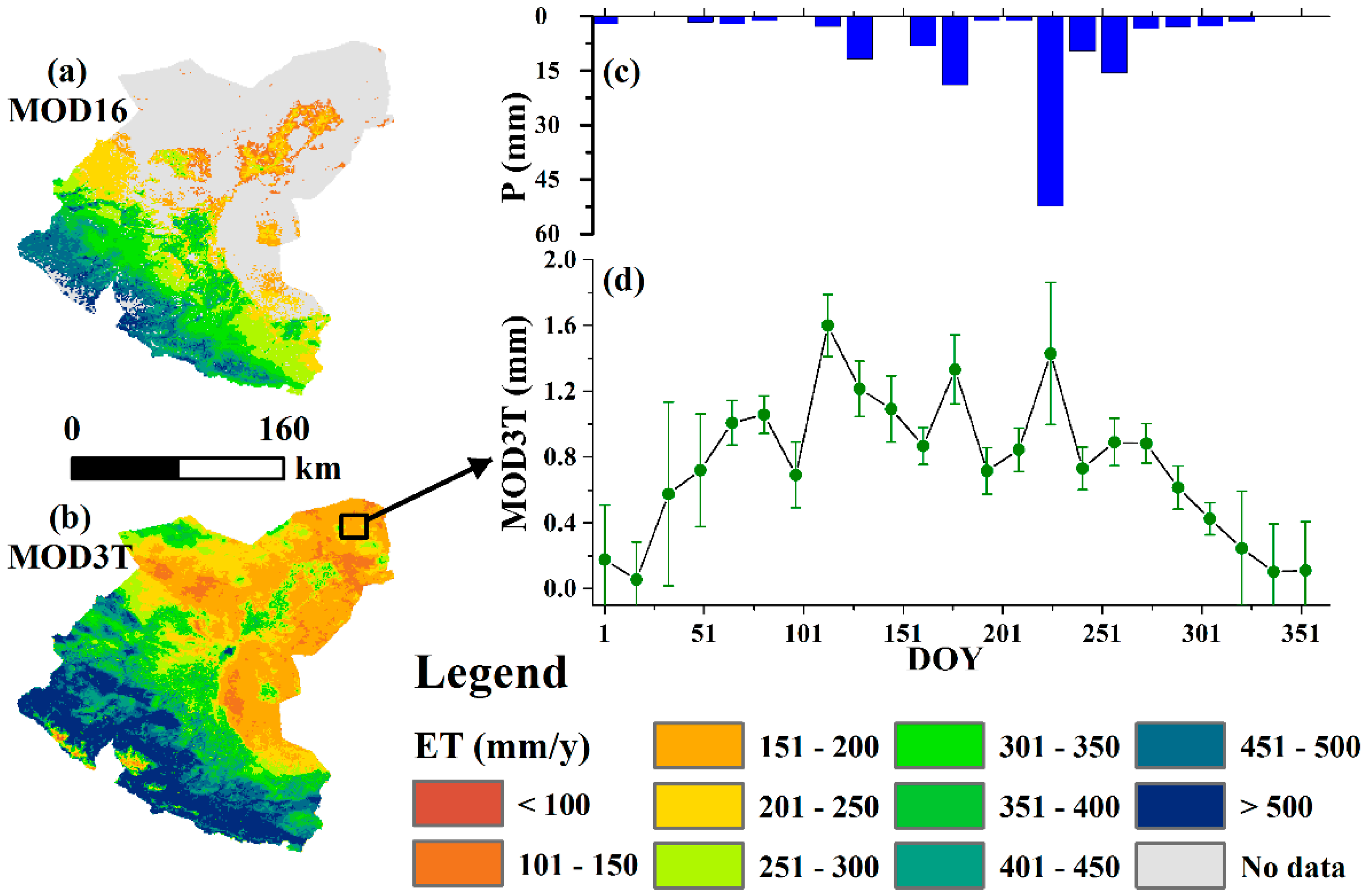
© 2019 by the authors. Licensee MDPI, Basel, Switzerland. This article is an open access article distributed under the terms and conditions of the Creative Commons Attribution (CC BY) license (http://creativecommons.org/licenses/by/4.0/).
Share and Cite
Liu, J.; Xiong, Y.; Tian, J.; Tan, Z. Spatiotemporal Changes in Evapotranspiration from an Overexploited Water Resources Basin in Arid Northern China and Their Implications for Ecosystem Management. Sustainability 2019, 11, 445. https://doi.org/10.3390/su11020445
Liu J, Xiong Y, Tian J, Tan Z. Spatiotemporal Changes in Evapotranspiration from an Overexploited Water Resources Basin in Arid Northern China and Their Implications for Ecosystem Management. Sustainability. 2019; 11(2):445. https://doi.org/10.3390/su11020445
Chicago/Turabian StyleLiu, Jianfu, Yujiu Xiong, Jianlin Tian, and Zhihang Tan. 2019. "Spatiotemporal Changes in Evapotranspiration from an Overexploited Water Resources Basin in Arid Northern China and Their Implications for Ecosystem Management" Sustainability 11, no. 2: 445. https://doi.org/10.3390/su11020445
APA StyleLiu, J., Xiong, Y., Tian, J., & Tan, Z. (2019). Spatiotemporal Changes in Evapotranspiration from an Overexploited Water Resources Basin in Arid Northern China and Their Implications for Ecosystem Management. Sustainability, 11(2), 445. https://doi.org/10.3390/su11020445




